Construction of a Compact Array of Microplasma Jet Devices and Its Application for Random Mutagenesis of Rhodosporidium toruloides
Themes: Conversion
Keywords: Genome Engineering
Citation
Koh, H.G., Kim, J., Rao, C.V., Park, S.J., Jin, Y.S. Oct. 21, 2023. Data from: “Construction of a Compact Array of Microplasma Jet Devices and Its Application for Random Mutagenesis of Rhodosporidium toruloides.” University of Illinois Urbana-Champaign. DOI: 10.13012/B2IDB-2992911_V1.
Overview

A small and efficient DNA mutation-inducing machine was constructed with an array of microplasma jet devices (7 × 1) that can be operated at atmospheric pressure for microbial mutagenesis. Using this machine, we report disruption of a plasmid DNA and generation of mutants of an oleaginous yeast Rhodosporidium toruloides. Specifically, a compact-sized microplasma channel (25 × 20 × 2 mm3) capable of generating an electron density of greater than 1013 cm–3 was constructed to produce reactive species (N2*, N2+, O, OH, and Hα) under helium atmospheric conditions to induce DNA mutagenesis. The length of microplasma channels in the device played a critical role in augmenting both the volume of plasma and the concentration of reactive species. First, we confirmed that microplasma treatment can linearize a plasmid by creating nicks in vitro. Second, we treated R. toruloides cells with a jet device containing 7 microchannels for 5 min; 94.8% of the treated cells were killed, and 0.44% of surviving cells showed different colony colors as compared to their parental colony. Microplasma-based DNA mutation is energy-efficient and can be a safe alternative for inducing mutations compared to conventional methods using toxic mutagens. This compact and scalable device is amenable for industrial strain improvement involving large-scale mutagenesis.
Data
Illinois Data Bank includes:
- Carotenoid contents
- Plasma jet relative intensity